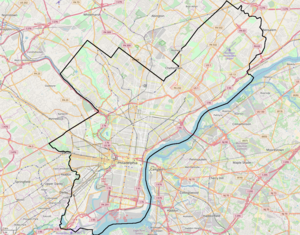40th Street Portal
 An outbound Route 36 trolley at the station | |||||||||||||||||||||||
| Location | 40th Street, Woodland, & Baltimore Avenues, Philadelphia, Pennsylvania | ||||||||||||||||||||||
| Coordinates | 39°56′58″N 75°12′12″W / 39.9495°N 75.2033°WCoordinates: 39°56′58″N 75°12′12″W / 39.9495°N 75.2033°W | ||||||||||||||||||||||
| Owned by | SEPTA | ||||||||||||||||||||||
| Platforms | 3 side platforms | ||||||||||||||||||||||
| Tracks | 3 | ||||||||||||||||||||||
| Connections | SEPTA City Bus: 30 | ||||||||||||||||||||||
| History | |||||||||||||||||||||||
| Opened | 1955 | ||||||||||||||||||||||
| Electrified | Overhead lines | ||||||||||||||||||||||
| Services | |||||||||||||||||||||||
| |||||||||||||||||||||||
| Location | |||||||||||||||||||||||
 40th Street Portal Location within Philadelphia | |||||||||||||||||||||||
The 40th Street Portal, also known as simply 40th Street station, is a SEPTA Subway-Surface Lines trolley station in Philadelphia. At this station's portal, four of the five Subway-Surface Lines enter the Woodland Avenue subway tunnel after running on the street in Southwest Philadelphia and nearby suburbs. Eastbound trolleys run in the tunnel under the nearby campuses of the University of Pennsylvania and Drexel University to Center City Philadelphia. Westbound trolleys travel to the Philadelphia neighborhoods of Eastwick and Angora and the Delaware County suburbs of Yeadon and Darby.
The station is located above ground at the entrance to the tunnel in a plaza between Woodland Avenue and Baltimore Avenue at 40th Street, adjacent to The Woodlands. When the tunnel is closed, trolleys are re-routed along 42nd Street to terminate at the 40th Street station of the Market–Frankford Line and do not serve this station.
History[]

The portal station was opened October 17, 1955,[1] by the Philadelphia Transportation Company (PTC) as part of a larger project to move portions of the elevated Market Street Line and surface trolleys underground.[2] The original project to bury the elevated tracks between 23rd to 46th streets was announced by the PTC's predecessor, the Philadelphia Rapid Transit Company (PRT), in the 1920s, but was delayed due to the Great Depression and World War II.[3] The PTC's revised project also included a new tunnel for trolleys underneath the campus of the University of Pennsylvania, continuing from the original western portal at 23rd and Market streets to two new portals, the other being at 36th and Ludlow streets for Route 10.[3]
However, service to the vicinity of 40th Street, Woodland Avenue, and Baltimore Avenue has existed long before then. Routes 11, 13, and 36 operated from their current outer termini of Darby and Eastwick to Front Street in Center City beginning December 15, 1906.[1][4][5][6]
Trolley Portal Gardens[]
In 2012, the University City District began a plan to overhaul the 40th street portal. The plan included replacing asphalt with green space and landscaping, benches, bike racks, new lighting, and a cafe fronting Baltimore Avenue.[7] The University City District raised $2.1 million for the project. Groundbreaking was in December 2016, but construction did not start until June 2017.[8] The 40th Street Trolley Portal Gardens officially opened as of September 27, 2018.[9][10] In August 2021, the garden was cleared by University City District due to overgrowth obstructing visibility for trolley operators and attracting pests. The organization plans to replant the garden in September 2021 with a new layout.[11]
Station layout[]

| Side platform | |
| Westbound | ← Route 34 toward 61st & Baltimore (42nd & Baltimore) |
| Side platform | |
| Westbound | ← Route 11 toward Darby T.C. (42nd & Woodland) ← Route 13 toward Yeadon Loop or Darby T.C. (42nd & Chester) ← Route 36 toward 80th Street–Eastwick (42nd & Woodland) |
| Eastbound | Routes 11, 13, 34, 36 toward 13th Street (37th Street) → |
| Side platform | |
References[]
- ^ a b Springirth, Kenneth C. (2008). Southeastern Pennsylvania Trolleys. Images of Rail. Arcadia Publishing. p. 91. ISBN 978-0-7385-5692-5 – via Google Books.
- ^ Puckett, John L. and Mark Frazier Lloyd. Becoming Penn: The Pragmatic American University, 1950-2000, p. 35, at Google Books, accessed May 31, 2020.
- ^ a b John L. Puckett. "Putting the Market Street Elevated Underground". West Philadelphia Collaborative History. University of Pennsylvania Graduate School of Education. Retrieved June 2, 2020.
- ^ ISEPTAPHILLY Blog. "Route of the Week - 11". SEPTA. Retrieved June 2, 2020.
- ^ ISEPTAPHILLY Blog. "Route of the Week - 13". SEPTA. Retrieved June 2, 2020.
- ^ ISEPTAPHILLY Blog. "Route of the Week - 36". SEPTA. Retrieved June 2, 2020.
- ^ "40th Street Trolley Portal upgrade update". PlanPhilly | 40th Street Trolley Portal upgrade update. Retrieved May 11, 2018.
- ^ "Construction begins this week at future 40th Street Trolley Portal Gardens". Curbed Philly. Retrieved May 11, 2018.
- ^ "40th Street Trolley Portal Gardens". University City District. November 12, 2014. Retrieved May 11, 2018.
- ^ "Philly Office Retail".
- ^ Briggs, Ryan (August 5, 2021). "West Philly's Trolley Portal Garden is clear-cut — but officials say plants will return in Sept". WHYY. Retrieved August 6, 2021.
External links[]
- SEPTA Subway–Surface Trolley Line stations
- Railway stations in Philadelphia
- Railway stations in the United States opened in 1955
- 1955 establishments in Pennsylvania
